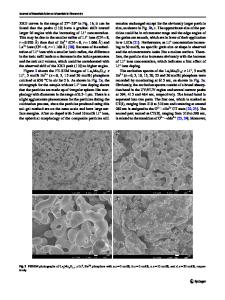Synthesis and characterization of Y 2 O 3 : Eu 3+ powder phosphor by a hydrolysis technique
- PDF / 366,236 Bytes
- 6 Pages / 612 x 792 pts (letter) Page_size
- 70 Downloads / 387 Views
MATERIALS RESEARCH
Welcome
Comments
Help
Synthesis and characterization of Y2 O3 : Eu31 powder phosphor by a hydrolysis technique Yong Dong Jiang and Zhong Lin Wang School of Materials Science & Engineering, Georgia Institute of Technology, Atlanta, Georgia 30332-0245
Fuli Zhang, Henry G. Paris, and Christopher J. Summers Phosphor Technology Center of Excellence, Georgia Tech Research Institute, Atlanta, Georgia 30332-0800 (Received 9 June 1997; accepted 9 January 1998)
A forced hydrolysis technique is used for preparing Y2 O3 : Eu31 powders at low processing temperatures. The technique uses yttrium oxide, europium oxide, and nitric acid and urea, and has the potential for large-scale production for industrial applications. Several experimental conditions have been examined to optimize the luminescence efficiency. The best result was found to be at 2 mol % Eu doping and a 2 h firing of 1400 ±C. Microstructural information provided by x-ray diffraction, scanning electron microscopy (SEM), and transmission electron microscopy (TEM) have been applied to interpret the observed luminescent properties.
I. INTRODUCTION
High resolution and high efficiency planar displays are one of the national priorities for advanced technology and commercial applications. High efficiency phosphor materials with crystalline monodispersive fine particles are the key for high resolution screens, displays, and flat panels.1,2 In these applications the quality of the phosphor particles is vitally important, and phosphor pixel size as small as ,10 mm in diameter are needed for high resolution displays. Such a fine pixel size naturally requires small phosphor particles of less than 5 mm in diameter. In practice, small size particles may improve aging by forming a densely packed layer. On the other hand, when the particle size becomes smaller than a critical value, the luminescence efficiency decreases. The possible reasons are attributed to increased light absorption and the effect of the surface layer; the latter is believed to quench luminescence.3 Therefore, developing synthesis techniques that can yield small phosphor particles with a high luminescent efficiency is pertained, and desperately needed. Yttrium oxide doped with Eu31 (Y2 O3 : Eu31 ) is one of the main red-emission phosphors used in high efficiency cathode ray tube (CRT) and field emission display (FED).3 However, preparation of yttria doped with Eu31 by the conventional ceramic method is cumbersome, because it employs a solid state reaction of the oxides at high temperatures with sequential grinding and firing steps. To achieve high quality small particle size of phosphor powders, various preparation routes have been adopted to reduce the reaction temperature, especially wet chemistry methods, such as sol-gel, coprecipitation, etc.4 Such processes can prepare amorphous particles 2950
http://journals.cambridge.org
J. Mater. Res., Vol. 13, No. 10, Oct 1998
Downloaded: 04 Apr 2015
in aqueous solution at low temperatures (,100 ±C) and have the potential to produce powder
Data Loading...











